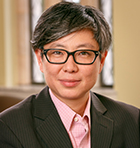
Dr. Tze M. Loo
-
Profile
My research is concerned with the colonial dimensions of the modern Japanese nation state, in both its prewar and wartime imperial expansion and also in how colonialism functioned in the making of modern Japan itself. I am interested in how the Japanese state reproduces itself and its power, and I pay attention to two technologies of government in particular. The first is how the Japanese state power makes itself felt through objects of material culture and cultural heritage; secondly, I am interested in the prewar Japanese state’s efforts to discipline the country’s religious landscape through the construction and deployment of State Shinto. I also trace how subjects of the Japanese state resist or contest these same technologies.
My book, Heritage Politics: Shuri Castle and Okinawa’s Incorporation into Modern Japan, 1879-2000 examines how Japan, America during its 27-year rule of the islands, and Okinawan people use Okinawa’s cultural heritage – particularly its iconic Shuri Castle – to negotiate and articulate the islands’ relationship to the Japanese mainland. While Japanese and the U.S. attempted to use the islands’ cultural heritage to discipline Okinawans according to their political agendas, Okinawans used representations of their cultural heritage as a powerful way to act against these larger powers and to negotiate a more equitable position for themselves within the Japanese national imaginary.
I am currently working on a new project that traces the Japanese state’s attempt to transpose Okinawa’s indigenous utaki-centered religion into the universe of State Shinto in the prewar period.
Expand All-
Grants and Fellowships
Japan Foundation Long-term research fellowship, September 2017-June 2018.
Social Science Research Council/Japan Society for the Promotion of Sciences Postdoctoral Fellowship, 2009-10.
-
Awards
2022 University of Richmond Distinguished Educator Award
-
Grants and Fellowships
-
Publications
Books
Heritage Politics: Shuri Castle and Okinawa’s Incorporation into Modern Japan, 1879-2000 (Lanham: Lexington, 2014)
Journal Articles“Trapped in Text: Women’s ritual power in Taisho Okinawa,” Journal of Asian Studies, 82: 2 May 2023: 184-205.
“Islands for an Anxious Empire: Japan’s Pacific Island Mandate,” American Historical Review 124, no. 5 (December 2019): 1699–1703.
“Paradise in a war zone”: The U.S. Military and Tourism in Okinawa, 1945–1972 in Japan Review 33 Special Issue: War, Tourism, and Modern Japan (2019): 173–193
“Introduction” to Remembering Industrial Development, Preserving the Dark Heritage, A special issue of Japan Focus, Vol. 15, 1: 1 (January 1, 2017)
“Escaping its Past: Recasting the Grand Shrine of Ise.” Inter-Asia Cultural Studies, 11:3 (2010), 375-392
* Also available in Japanese as “Kako kara no da’shutsu: Ise dai jingū no sai kōchiku,” trans. by Takahashi Norihito for Kokugakuin University, 21st Century of Excellence Program, Establishment of a National Learning Institute for the Dissemination of Research on Shinto and Japanese Culture, 2013 (http://21coe.kokugakuin.ac.jp/articlesintranslation/)
“The Okinawa Problem,” International Herald Tribune, 10 June 2010
“Shuri Castle’s Other History: Architecture and Empire in Okinawa,” The Asia-Pacific Journal, Vol. 41-1-09, October 12, 2009
Book Chapters“Space and Power in Okinawan Religion” in Jolyon B. Thomas and Matthew D. McMullen (eds.), The New Nanzan Guide to Japanese Religions (forthcoming from the University of Hawai‘i Press)
“The Politics of Japan’s Use of World Heritage: From Ratifying the World Heritage Convention to the Mozu-Furuichi Tumulus Clusters” in Aike P. Rots and Mark Teeuwen (eds.), Sacred Heritage in Japan (New York: Routledge, 2020)
“Singapore: Commemoration and Reconciliation,” in Daqing Yang and Mike Mochizuki (eds.), Anniversary Politics: Commemorations of WWII in the Asia Pacific in 2015 (Lanham: Lexington Books, 2018)
“Historical Reconciliation in Southeast Asia: Notes from Singapore” in Melissa Nobles and Jun-Hyeok Kwak (eds.), Historical Reconciliation and Inherited Responsibility (New York: Routledge, 2013)
“Rearticulating Belonging: The Postwar Rebuilding of Shuri Castle” in Nagai Hiroko and Tito Vincente (eds.), Memories, Monuments and Media: Representations of Conflicts and Creation of Histories in Asia (Manila: Ateneo de Manila University Press, 2012)
ReviewsReview of A Social History of the Ise Shrines: Divine Capital. By Mark Teeuwen and John Breen (London: Bloomsbury, 2017) Journal of Religion in Japan, 7: 3 (Spring 2019)
Review of The Ryukyu Kingdom: Cornerstone of East Asia. By Mamoru Akamine; translated by Lina Terrell and edited by Robert Huey. (Honolulu: University of Hawai’i Press, 2017), Journal of Japanese Studies, 44: 2 (Summer 2018)
Review of Architecturalized Asia: Mapping a Continent through History. Edited by Vimalin Rujivacharakul, H. Hazel Hahn, Ken Tadashi Oshima, Peter Christensen. (Honolulu: University of Hawaiʻi Press, 2014), Pacific Affairs, 88: 4 (December 2015)
OtherTakazane Yasunori, translated and introduced by Tze M. Loo, “Should ‘Gunkanjima’ be a World Heritage site? – The forgotten scars of Korean forced labor,” The Asia-Pacific Journal, Vol. 13, Issue 28, No. 1, July 13, 2015.